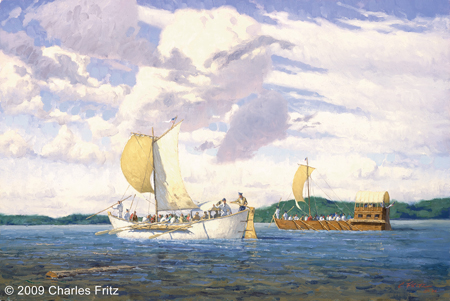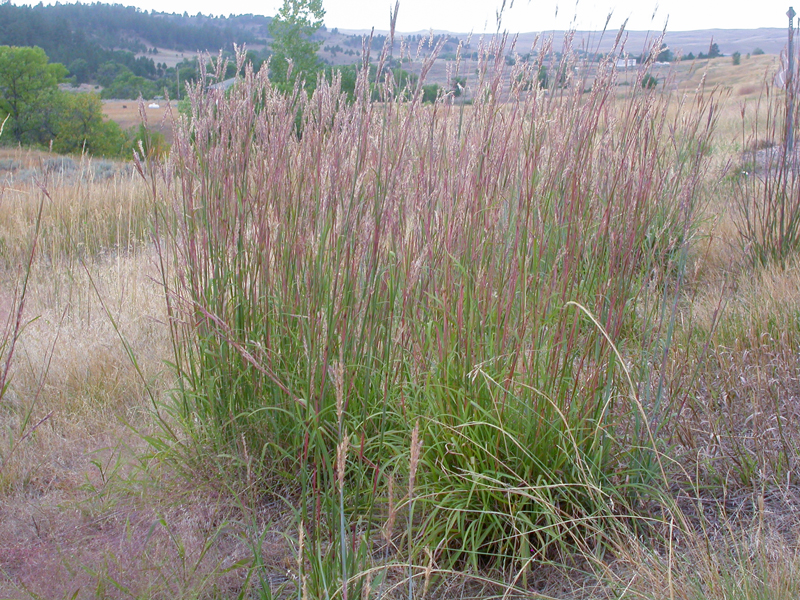At White Catfish Camp, the boats are loaded, and they proceed to present Lewis and Clark Landing in Omaha, Nebraska. A knee is cut, mosquitoes rage, and Lewis adds several plants to his collection.
Leaving White Catfish Camp
by Yellowstone Public Radio[1]Originally aired weekdays by Yellowstone Public Radio during the Bicentennial observance of 2003-2006. Narrated by Hal Hansen. Scripts by Whit Hansen and Ed Jacobson. Produced by Leni Holliman. © … Continue reading
The White Pirogue under Sail
20″ x 30″ oil on canvas
© 2009 by Charles Fritz. Used by permission.
Leaving White Catfish Camp
at 10 oClock Commence Loading the Boat & perogue; had all the Ores Completely fixed; Swam over the two remaining horses to the L. S. with the view of the Hunters going on that Side, after Getting everry thing Complete, we Set Sale under a gentle breeze from the South and proceeded on
—William Clark
Whitehouse’s Cut Knee
as we were Setting out to day one man [George Shannon] Killed a Buck & another Cut his Knee [Joseph Whitehouse] verry bad
—William Clark
Lewis and Clark Landing
we passed a prarie on The S. S. we passd. many sand bars, the River very crooked; came about 15 miles & Camped on a bank of a high prarie, among a Grove of Cotten wood.
—Joseph Whitehouse
Indian Mounds
I took one man R. Fields and walked on Shore with a View of examoning Som mounds on the L. S. of the river— those mounds I found to be of Deffirent hight Shape & Size, Some Composed of Sand Some earth & Sand, the highest next to the river all of which covered about 200 acres of land, in a circular form on the Side from the river a low bottom & Small pond. The Otteaus [Otoes] formerly lived here I did not get to the boat untile after night.
—William Clark
Raging Mosquitoes
a butifull Breeze from the N W. this evening which would have been verry agreeable, had the Misquiters been tolerably Pacifick, but thy were rageing all night, Some about the Sise of house flais [flies]
—William Clark
Lost Plant Specimens
Lost Specimen No. 17
No. 17. Taken on the 27th of July, the appearance of the bush is much like the privy and about the same hight it grows about the borders of the open praries . . . . the buries or fruit a small round bury of a deep perple coulour nearly black . . . . they look handsome but tast insipid.
—Meriwether Lewis
This specimen, received by John Vaughn in 1805 (see The Donation Book), remains unidentified.[2]Gary E. Moulton, ed. Journals, “Fort Mandan Miscellany”, vol 3:456, 468.
Canada Wild Rye Specimen
No. 20. A specemine of wild Rye taken on the 27th of July, this grass is common to all the low praries above the Cancez river it rises to the hight of six feet and upwards and resembles the rye extreemly in appearance the geese and ducks feed on it when young, as they do also on the grain when ripe in September and October it produces much grain tho of an inferior quality compared with cultivated rye.——
—Meriwether Lewis
Moulton identifies this lost specimen, received by John Vaughn in 1805, as Elymus canadensis, Canada wild rye.[3]Ibid., 457, 468.
Virginia Wild Rye Specimen
No 21. is another species of the wild rye it dose not grow as tall as No. 20 neither does it like that species confine itself so much to the open ground; it is sometimes found in the timbered land. the grain it produces is [n]either so large or so abundant as the former.—
—Meriwether Lewis
Moulton identifies this lost specimen, received by John Vaughn in 1805, as Elymus virginicus, Virginia wild rye.[4]Ibid.
Big Bluestem Specimen
No. 22. 23. 24 & 25. Are various species of grasses which appear in the praries, No. 23 is the most common of any other grass, it rises to the hight of from 4 to 8 feet and never bears any flower or seed that I ever observed and suppose therefore that it must propegate by means of the root: common to all praries in this country.
—Meriwether Lewis
Moulton identifies lost specimen No. 23, received by John Vaughn in 1805, as Andropogon gerardi Vitman, big bluestem.[5]Ibid.
White Catfish Camp is a High Potential Historic Site along the Lewis and Clark National Historic Trail managed by the U.S. National Park Service. Across from White Catfish Camp, on the Nebraska side, the Fontenelle Forest provides trails and Lewis and Clark interpretation.
Notes
| ↑1 | Originally aired weekdays by Yellowstone Public Radio during the Bicentennial observance of 2003-2006. Narrated by Hal Hansen. Scripts by Whit Hansen and Ed Jacobson. Produced by Leni Holliman. © 2003 by Yellowstone Public Radio. |
|---|---|
| ↑2 | Gary E. Moulton, ed. Journals, “Fort Mandan Miscellany”, vol 3:456, 468. |
| ↑3 | Ibid., 457, 468. |
| ↑4 | Ibid. |
| ↑5 | Ibid. |




